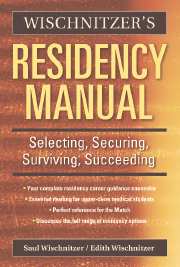Book contents
- Frontmatter
- Contents
- Tables and Forms
- Preface
- Message to the Reader
- Abbreviations
- PART ONE SELECTING A SPECIALTY
- PART TWO SECURING A RESIDENCY
- 7 Laying the Groundwork
- 8 Getting Started
- 9 Residency Program Selection
- 10 Applying for a Residency
- 11 The Residency Interview
- 12 Facing the Match
- PART THREE SURVIVING A RESIDENCY
- PART FOUR SUCCEEDING IN PRACTICE
- Appendix 1 Major Professional Organizations
- Appendix 2 Sample Resumes
- Appendix 3 Personal Statement
- Glossary
- Bibliography
- Index
9 - Residency Program Selection
Published online by Cambridge University Press: 08 August 2009
- Frontmatter
- Contents
- Tables and Forms
- Preface
- Message to the Reader
- Abbreviations
- PART ONE SELECTING A SPECIALTY
- PART TWO SECURING A RESIDENCY
- 7 Laying the Groundwork
- 8 Getting Started
- 9 Residency Program Selection
- 10 Applying for a Residency
- 11 The Residency Interview
- 12 Facing the Match
- PART THREE SURVIVING A RESIDENCY
- PART FOUR SUCCEEDING IN PRACTICE
- Appendix 1 Major Professional Organizations
- Appendix 2 Sample Resumes
- Appendix 3 Personal Statement
- Glossary
- Bibliography
- Index
Summary
Overview
Based on the sources of information regarding residencies provided in Chapter 8, a significant number of programs in your specialty should come to your attention. Their number needs adjustment relative to your own competitiveness, how difficult it is to secure a position in the specialty you have chosen, and personal considerations. This entire issue will be discussed in the first section of this chapter. Next will come a section entitled Strategy for applying, to facilitate obtaining interviews. This subject will be followed by considering how you evaluate a program at an interview, so that you can properly prepare a Rank Order List for the Match, after all your interviews have been completed.
Selecting prospective programs
In this section, a procedure is presented on how to carry out a preliminary screening of residency programs to see if they meet your basic needs. This is done by determining if the training institution is suitably located and if it is the type of appointment that you seek. Other significant personal issues should also be checked at this point. By this means you should formulate a group of prospective residency programs, which then can be reduced to a reasonable level, as is discussed of p. 125.
Once you have reduced the prospective residency program number to a reasonable number, the interview invitations you receive will allow you to proceed further and formulate a Rank Order List for the Match.
- Type
- Chapter
- Information
- Wischnitzer's Residency ManualSelecting, Securing, Surviving, Succeeding, pp. 123 - 135Publisher: Cambridge University PressPrint publication year: 2006

